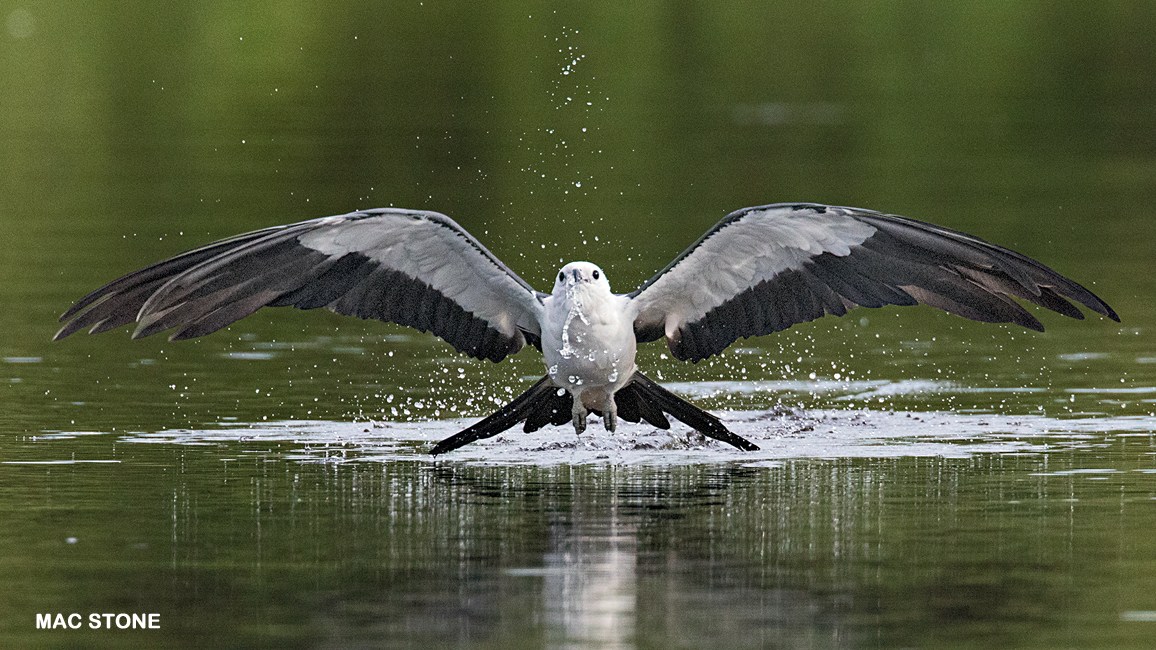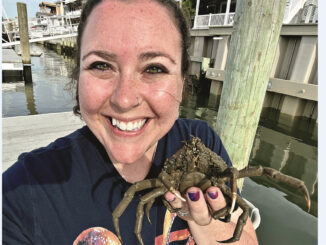
Catching Kites in Flight
By Anne Cissel; Photos by Mac StoneThese birds prefer life in the air. But to help them survive, scientists must bring them down to Earth.

Swallow-tailed kites do nearly everything while flying: hunting, eating, drinking, even bathing! These light and graceful raptors, or birds of prey, barely flap their wings to stay up in the air. A swallow-tailed kite is the size of an average hawk but weighs half as much—less than a pound. That’s why kites look as if they’re floating, not flying! Soaring high above the trees, they hardly ever stop to land.
Many swallow-tailed kites spend their summers in the southeastern part of the United States (see map). They’re also found in parts of Central and South America. Look for them flying over land such as the marsh seen here in the background. They also like open forests and swamps. But there are far fewer of these acrobatic birds than there once were. In order to help the kites, scientists need to learn more about the threats the birds face. And that means getting up close and personal with these high-flyers!

ACROBATIC DINER
Swallow-tailed kites are built to chase and catch their favorite meals: flying insects. Their forked tails help them make tight turns. Sometimes the birds will even roll backward to catch an insect that is flying behind them.
Surprisingly, they often munch on insects that bite or sting, especially wasps! It gives new meaning to the phrase “grab a bite,” doesn’t it? Luckily, their feathers and the tough skin on their legs and feet protect them from stings. Their stomachs have thick linings, too. But most of the time, kites just pull out any stingers before gulping the insects down!
SKY-HIGH NESTING
One thing kites can’t do while flying is lay eggs. But they do nest as far from the ground as possible—sometimes way up in trees more than 100 feet tall. That’s about as tall as a 10-story building!
The kites start nesting in March. A mother and father build the nest together and take turns keeping the eggs warm. When the chicks hatch, the male hunts while the female stays in the nest to protect her young. The chicks usually get bigger meals than the adults do, such as treefrogs, lizards, baby birds, and snakes. Mom uses her sharp beak to tear it all up into smaller pieces for her chicks.
Scientists sometimes climb all the way up to a nest to check on the chicks’ health. They also place cameras near the nest so they can observe from down below.
FRIENDLY FLOCK
Most birds of prey like to live alone, but kites nest in “neighborhoods” with other kite families. In late summer, swallow-tailed kites leave the United States to fly to South America. Before heading south, thousands of them gather in areas to roost, or rest, together. They have to take a breather before the big trip ahead!

WHOOOOOO’S HELPING KITES?
Swallow-tailed kites used to live in 21 U.S. states. Now they are found in only seven. That’s because farms, buildings, and roads have taken over so much of the kites’ natural habitat. Scientists at the Avian Research and Conservation Institute study kites to learn how best to help them. To track their movements, scientists carefully attach electronic transmitter “backpacks” onto the birds. But putting a backpack on a bird that hardly ever touches the ground is not easy! It’s time to meet the surprise
helper in this story: a great horned owl.
How does a completely different bird of prey help capture a kite? The owl is used as a lure. This type of owl preys on the kites’ eggs and chicks—sometimes even a sleeping adult! When a kite sees this enemy near its nest, it flies toward it to scare it away.
The owls that are part of this project were injured and nursed back to health by humans. The owls are used to being handled by people. So they stay calm when they are leashed to a perch near a kite’s nest.
When a kite flies toward the owl, it gets caught in a special net the scientists have set up. Right away, the kite is carefully taken out of the net. The scientists give the bird a health check, put an ID band on, and attach the electronic transmitter. Then the kite is released to fly free once again.
These transmitters have already shown that some kites migrate all the way to southern Brazil—a trip of nearly 5,000 miles! Learning more about these fantastic flyers will help scientists make sure more of them glide and soar in American skies for a long time to come.
















